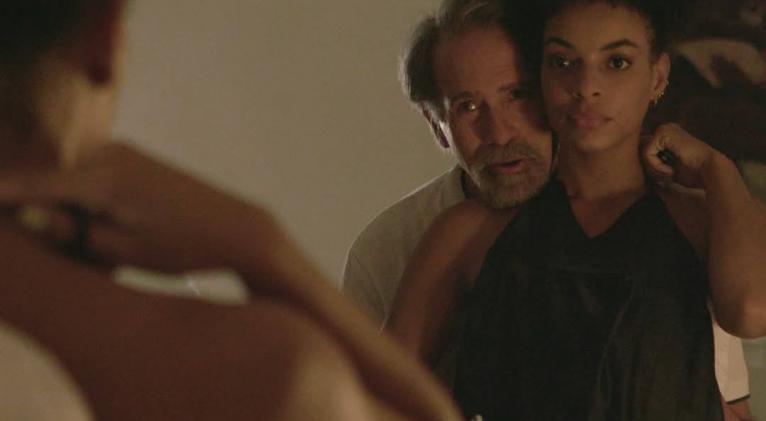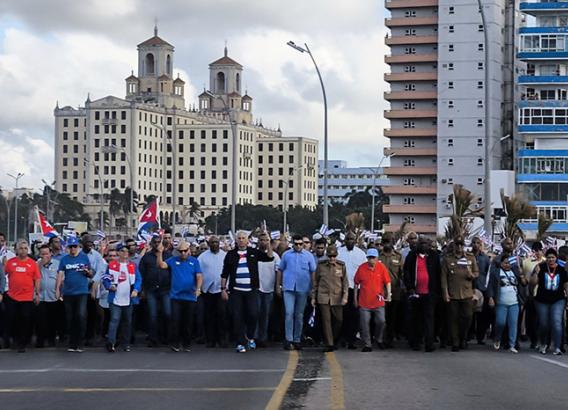On Television, the Masks and Shadows of Violence
especiales

A new production by director Elena Palacio invites viewers to reflect and empathize on Sunday nights, delving into the diverse and often intricate paths of violence, along with its wounds and scars. With this in mind, we spoke with the creator of Los gatos, las máscaras, las sombras.
What motivated you to create this television series?
“In terms of motivation, I believe this has been one of the topics that I have been interested in the most since I began my career as a director and screenwriter, both in my own projects and those written for other filmmakers. It is a subject I am familiar with and consider essential for television. It must be presented from different angles and perspectives through a variety of programs. I firmly believe it should always be present, serving as a reminder and a means of generating awareness and impact. Furthermore, as I have mentioned on other occasions, this series was also commissioned by the Cubavisión channel due to my experience and commitment to the subject of violence.”
Are the stories presented based on real events, or are they entirely fictional?
“The stories are fictional, but they are inspired, to a greater or lesser extent, by real cases, anecdotes, or a synthesis of various close experiences. They draw from situations I have observed in my surroundings, in friendships, in family, as well as from extensive research conducted with our specialized advisor, Ivón Hernán. Her vast experience in supporting women affected by violence has been an invaluable source of insight.
“None of the episodes are based on a single specific case. However, for example, the story of Lisy, which unfolds throughout the entire series as a painful memory for the doctor —who represents professionals dealing with these situations— was inspired by a testimony shared by Ivón Hernán. I later enriched it with other stories and situations.
“The construction of each fictional narrative is rooted in the authenticity of the information gathered, whether through testimonies, literature, documentaries, or studies on the subject. An example of this is the episode on child sexual abuse, for which we referred to several podcasts and a specific documentary. It is truly overwhelming to see how this type of abuse is alarmingly similar across different countries and cultures, how it remains hidden within the family, and how patterns of aggression continue to be perpetuated.”
Tell us a bit about the cast participating in the series...
"As for the cast, I had Daisy Quintana as the doctor who, in addition to being a psychiatrist, works in a counseling center supporting women in violent situations. This woman’s personal life also unfolds throughout the series, with Rosalí Suen as her daughter, Daniel Barrera as her daughter’s boyfriend, and Luis Alberto García as a longtime friend, also a psychiatrist in the story, with whom there is a potential romantic relationship.
"The cast also includes Laura Moras, Roque Moreno, Yenei Bejerano, Bryan Jardines, Mayra Mazorra, Ana Flavia Barrios, Pedro Díaz, Julio Cesar Ramírez, Zailin Carbonell, Paula Alí, Yudexy de la Torre, Jorge Luis de Cabo, Ana Gloria Buduén, Yessie Guridi, Jorge Martínez, Ary Fonseca, Delvys Rodríguez, Yeissy Zubiaur, Patricio Wood, and Ayma Martínez…
"There are also guest actors, special appearances, and other supporting actors and actresses —quite a number of them. Additionally, I have a group of very talented children and teenagers from Massiel Dueñas’s group, and she herself participates as a guest actress."
These are always complex topics. How do you develop a plausible and respectful proposal that addresses such harsh realities, provides lessons, and still meets the codes and appeal expected in a television series?
"We knew from the beginning that we would face complicated, difficult stories due to the themes we had chosen. I say 'we' because Ivón, my advisor —whom I must always mention— and I, as the screenwriter, along with some friends I invited to co-write based on the arguments I provided, were all involved. I was very careful in controlling the threads of the stories, as the responsibility in handling the topic, both in the script and on screen, was my guiding principle. The delicacy in approaching the subject, avoiding saturation, not leaning into excessive visualizations of violence —treating it, for example, through ellipsis, through the soundtrack, achieving a visual and aesthetic treatment that is not violent, paradoxically, which in contrast can be intense, because it creates that paradox that can evoke a much stronger emotion in the viewer. But that was precisely the point —to appeal to emotion, which I believe is the basic and powerful weapon of fiction, using all these visual resources while trying not to go overboard, to address the necessary edges.
"For example, in the episode about the girl who dies, which is a hot, controversial, and concerning topic, we tried to show the danger of relationships that become possessive and explain why it is difficult to break free from them; how outsiders perceive them; the terrible nature of these possessive feelings, what they can trigger, and why they are generally associated with male dominance. We could not avoid showing this topic, but at the same time, the issue of child abuse, which is so sensitive —I am very pleased with how we handled it, because it unfolds with an apparent beauty, an apparent mystery, like a suspense story until things are revealed in an elliptical way, through the soundtrack, because we knew it could be painful and shocking if we crossed the line.
"There is also the story of the trans girl, Chelo. We were careful in selecting the violence to portray. We know that trans people, especially trans women, experience a spectrum of terrible violence at various levels, but in bringing this to Cuban television, we chose one specific instance because it seemed healthier to alert viewers about how it is impossible not to view relationships and situations involving trans women with suspicion, as the possibility of violence is always latent, even when their lives seem resolved or in an apparent plateau of calm and acceptance. So, we went that route, focusing on a family conflict unrelated to acceptance or coming out. On the contrary, this character begins the story in a family that knows who she is, with a nephew who adores her and cares for her as if she were his mother. It is another trigger that brings out these shadows and drops the masks, so to speak, alluding to the title."
What messages about violence do you wish to convey with this series?
"Important messages: first, the issue of victims and the false, terrible, dangerous notion of a 'good victim' in cases of violence —the idea that some people 'deserve' it because of how they dress, who they associate with, or how they behave. That is, the terrible myth of the good and bad victim, the myth of complicity, of not getting involved, of looking away because it is not my business, because 'what happens between husband and wife…' The fact that violence occurs across all social strata, debunking the idea that victims are only from lower cultural levels, or that perpetrators are always alcoholics from lower social classes —these were important messages. Above all, the idea that we must be alert, that it could be happening in your own home, because violence hides, it masks itself. It is plural, and we might only notice the more obvious, physical forms, but it is crucial to recognize all forms, to understand what constitutes violence, the importance of saying no, of setting boundaries. All these messages are extremely important to me and are present in the series."
This is not the first time your audiovisual work has approached themes related to women and violence. Is it an intentional choice as a female creator to address these topics?
"Of course, it has been an intention of mine for years, and one I maintain and will continue to maintain. I say that in female-themed stories, even when addressing relationships and focusing on women, it is very difficult not to encounter violence, micro-violences, for those who know how to recognize them. For me, it is impossible to read a story with the idea of adapting it and not notice certain things related to gender perspectives or specific types of violence. So yes, it is an intention, something that marks my work, and it is done with full awareness."
Translated by Sergio A. Paneque Díaz / CubaSí Translation Staff














Add new comment